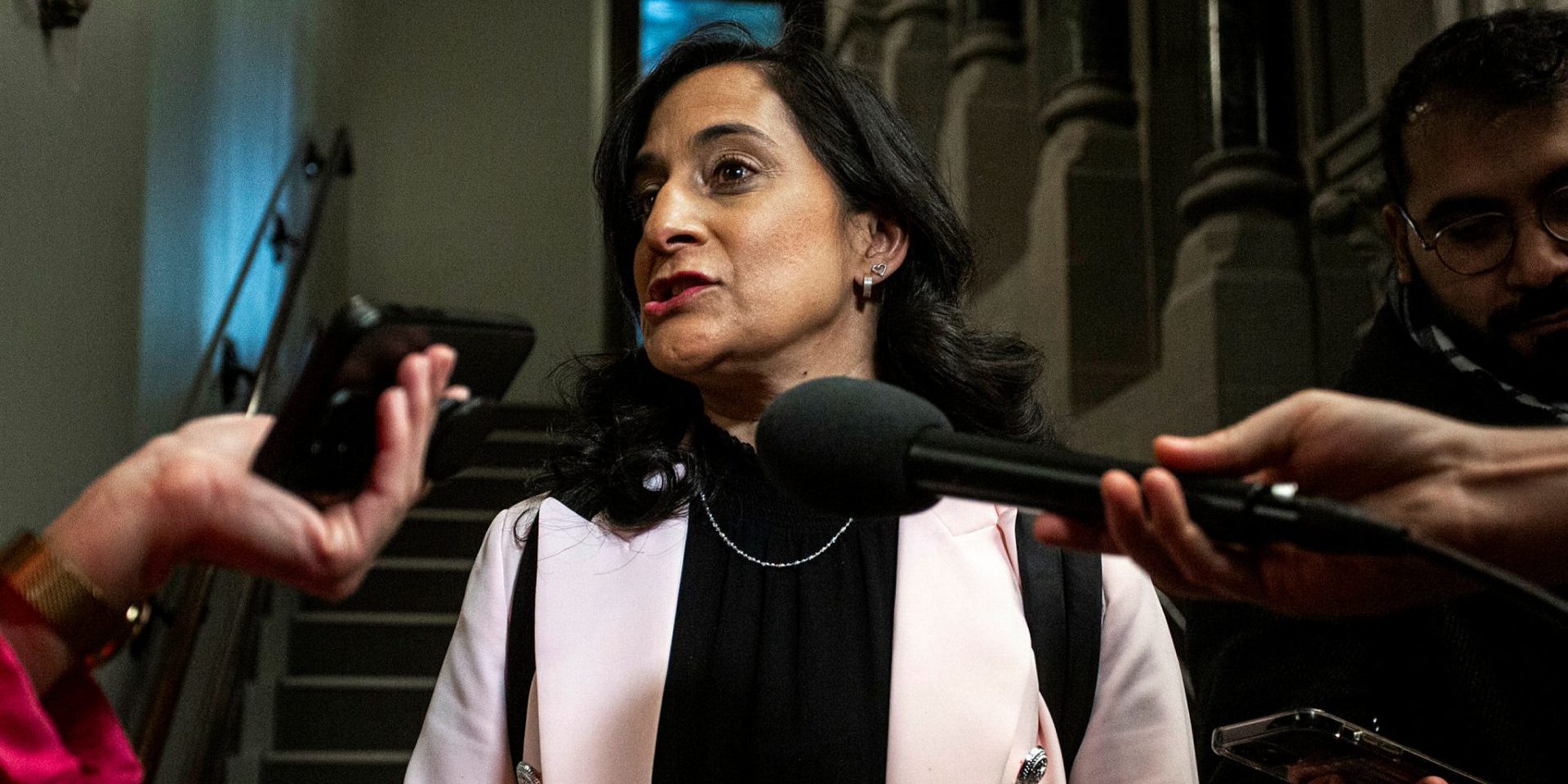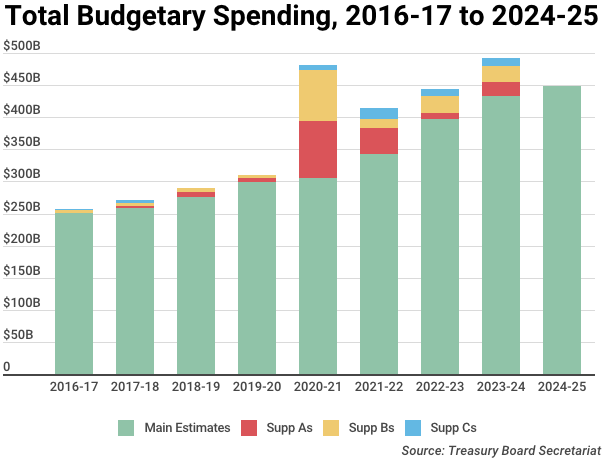Main estimates asks jump 3.8 per cent to reach $449.2-billion in budgetary spending

Despite the federal government’s plans to reduce spending by more than $14-billion by 2027-28, the most recent main estimates lay out money asks that are up almost 3.8 per cent from last year’s mains.
The 2024-25 main estimates, the government’s first funding request for the fiscal year, which will be followed by a series of supplementary estimates, were tabled in the House of Commons by Treasury Board President Anita Anand (Oakville, Ont.) on Feb. 29.
The majority of the $449.2-billion ask, or $257.6-billion, is statutory budgetary spending—spending already authorized through and required by legislation—while roughly $191.6-billion will need to be approved through House votes. The main estimates also include roughly $1.2-billion in non-budgetary spending, defined as “net outlays and receipts related to loans, investments, and advances.”
By contrast, the 2023-24 mains laid out a total of $432.9-billion in budgetary spending (of which $198.2-billion was voted on) and roughly $269.4-million in non-budgetary spending.
As highlighted in the Parliamentary Budget Officer’s (PBO) March 7 report analyzing the main estimates, roughly 63 per cent or $283-billion of the budgetary spending is transfers to other levels of government, including an $81.1-billion transfer for elderly benefits, and $52.1-billion related to the Canada Health Transfer. Operating and capital costs for federal departments and agencies make up 26.6 per cent of the spending authorities being sought, or $119.7-billion, while interest payments on public debt account for 10.4 per cent at $46.5-billion.
“While total budgetary authorities are increasing in this year’s main estimates, the pace of growth … has slowed compared to the pandemic years,” reads the PBO report. “Additionally, for the first time since the pandemic, voted budgetary authorities have decreased compared to the previous years’ main estimates. … However, voted authorities remain roughly 50 per cent higher than in the pre-pandemic 2019-20 main estimates.”

In an attached annex, the government also broke down how much previously announced spending will be “refocused” this year, and how much planned spending will be “reallocated” in the future. Overall, $2.3-billion in spending will be refocused in 2024-25, with $3.6-billion to be reallocated in 2025-26 and $4.8-billion in 2026-27.
The government has made a deliberate push not to use the word “cuts” in describing its announced spending overhaul, which aims to “reduce spending” by $14.1-billion over five years starting in 2023-24, and by $4.1-billion annually thereafter.
The $2.3-billion being “refocused” in 2024-25 involves spending that has already been committed for this fiscal year (for example, through previous supply bills) and will be redirected through the main estimates. This amount, though, doesn’t necessarily represent a cut. The dollars identified will either be spent on different priorities—potentially even within the same department or agency—than they were originally attached to, or they’ll go back to the public purse. The annex does not specify how much of the amounts listed will be outright reductions and how much will be used for new purposes, though the corresponding departmental plans reports—which were also tabled by Anand on Feb. 29—offer a bit more guidance on spending reduction plans.
The Department of National Defence (DND) will see the largest amount “refocused” in 2024-25 at $810.4-million, followed by the Department of Public Works and Government Services at $148.2-million, and the Department of Industry at $141.2-million.
Spending shakeup: notable shifts in 2024-25 main estimate asks
Eleven out of 129 federal department and agencies are seeking more than $5-billion in voted budgetary expenditures through the 2024-25 mains, with DND leading the pack at $28.8-billion, followed by the Department of Indigenous Services at $20.9-billion, and the Department of Employment and Social Development (ESDC) at $11.5-billion.
Those aren’t the full amounts being requested by each department, as it doesn’t account for statutory budgetary spending or non-budgetary spending. Looking at total spending, 14 departments and agencies are seeking more than $5-billion through the mains, with the Department of Finance leading the pack at $143.1-billion, of which only roughly $145.2-million will be voted on. Finance is followed by ESDC at $98.7-billion overall, DND at $30.6-billion, and Indigenous Services at a little more than $21-billion.
Comparing budgetary spending allocations between the 2024-25 main estimates and last year’s main estimates, The Hill Times identified 30 federal departments and agencies which will see spending authorizations change by $100-million or more in either direction.
Nine of those 30 have reduced budgetary spending allocations. Indigenous Services tops that list with roughly $21-billion in budgetary spending, down from the $39.6-billion it sought through the 2023-24 mains—an almost $18.6-billion, or 46.9 per cent, decrease.
According to the department, this decrease is “primarily” due to the one-time inclusion of $20-billion in spending related to the First Nations child welfare settlement in 2023-24 (for which another $3.3-billion was later allocated through the subsequent supplementary estimates), “offset by a one-time investment in the Northern Ontario Grid Connection Projects and an increase in core funding for the continued implementation of Jordan’s Principle.”
Next in line is the Public Health Agency of Canada (PHAC), which got $4.2-billion through the 2023-24 mains but is seeking almost $1.9-billion through this year’s main estimates—a 55.7 per cent, or $2.3-billion, drop.
As explained by a spokesperson, this decrease “reflects the agency’s ongoing post-pandemic demobilization, including the expiry of the temporary budget authorities in 2023-24 for the procurement of COVID-19 vaccines (-$2.315-billion), the phasing out of temporary mental health support during the pandemic (-$76.9-million), and sero-surveillance (-$65.5-million).”
PHAC is followed by Infrastructure Canada, which is seeking roughly $1.4-billion less at $8.2-billion for 2024-25, down 14.9 per cent from the roughly $9.6-billion it got through the 2023-24 mains. The Department of Public Safety and Emergency Preparedness, meanwhile, is seeking about $1.6-billion through the 2024-25 main estimates, down roughly $1-billion or 39.4 per cent from the $2.6-billion it got through last year’s mains.
While a drop in funding for Public Safety may seem counterintuitive given the rising rate of natural disasters, according to a departmental spokesperson, it comes down to how funding is doled out through the federal Disaster Finance Assistance Arrangements (DFAA) program, as provinces and territories are able to bring forward claims for funding through this program over the span of five years (after a disaster). “The decrease in the [2024-25] mains is mainly attributed to an anticipated reduction in funding levels for the” DFAA program, said the spokesperson. “If provincial and territorial claim settlements exceed the amount anticipated, additional funding would be sought at the next opportunity” in subsequent supplementary estimates.
Looking at the 21 departments and agencies for which budgetary spending has increased by $100-million or more, eight saw increases of more than $1-billion.
Finance Canada tops that list with $143.1-billion in budgetary spending being sought through this year’s main estimates, compared to $128.9-billion in the 2023-24 mains—an increase of $14.1-billion, or almost 11 per cent. Asked to explain the increase, the department wasn’t able to provide a response by filing deadline, but looking at the tabled report, there’s a $14-billion difference in statutory spending between the 2023-24 and 2024-25 mains. Statutory expenses for the department include Canada Health Transfer payments, the Canada Social Transfer, fiscal equalization payments, territorial financing, and interest on unmatured debt, among other things.
ESDC saw the next highest jump, with its $98.7-billion for 2024-25 representing an almost $4.6-billion or 4.9 per cent increase from the roughly $94.2-billion it got through the previous year’s mains.
The Department of Health is seeking more than double what it got through the 2023-24 main estimates, with $8.7-billion sought through the 2024-25 mains compared to $4.1-billion the year prior—an increase of almost $4.6-billion, or 111.7 per cent.
Health Canada said two programs are “most notably” contributing to the department’s increase in funding: roughly $2.6-billion tied to the Working Together to Improve Health Care for Canadians program, and almost $2.1-billion for Dental Care for Canadians and the interim Canada Dental Benefit.
DND is requesting almost $4.1-billion more through the 2024-25 estimates than it did through the previous year’s main estimates, at $30.6-billion compared to almost $26.5-billion in 2023-24—an increase of 15.5 per cent.
Health isn’t the only department to more than double its spending request compared to the 2023-24 mains. Of the 21 departments and agencies for which budgetary spending has increased by $100-million or more, two others—the Department of Agriculture and Agri-Food, and the Canadian Air Transport Security Authority (CATSA)—have requested amounts more than twice what was sought over the same period in 2023-24.
Agriculture is seeking a total of more than $3.7-billion in the most recent mains, up $1.9-billion or 104.8 per cent from the roughly $1.8-billion it got through the 2023-24 mains. According to the department, this increase is “due primarily to the renewal of services and programs under the Sustainable Canadian Agricultural Partnership and the renewal of the Dairy Direct Payment Program,” neither of which were included in last year’s main estimates and were instead captured in subsequent supplementary estimates due to the timing of their respective approvals.
CATSA is seeking $1.2-billion through this year’s main estimates, up $632.9-million or 112.7 per cent from the $561.4-million sought in the 2023-24 mains.
The Hill Times
Comparing main estimate totals
| 2023-24 Main Estimates | 2024-25 Main Estimates | |
| Budgetary Voted | $198.2-billion | $191.6-billion |
| Budgetary Statutory | $234.8-billion | $257.6-billion |
| Total Budgetary | $432.9-billion | $449.2-billion |
| Non-Budgetary | $269.4-million | $1.2-billion |
| Overall Total | $433.2-billion | $450.4-billion |
Comparing budgetary spending, variations of $100-million or more
| Department/Agency | 2023-24 Mains | 2024-25 Mains | Difference ($) | Difference (%) |
| Finance | $128,937,079,682 | $143,050,168,848 | $14,113,089,166 | 10.95% |
| ESDC | $94,152,310,938 | $98,732,220,093 | $4,579,909,155 | 4.86% |
| Health | $4,100,226,285 | $8,678,602,524 | $4,578,376,239 | 111.66% |
| National Defence | $26,489,124,243 | $30,584,803,954 | $4,095,679,711 | 15.46% |
| Canada Revenue Agency | $14,874,529,632 | $17,579,455,563 | $2,704,925,931 | 18.18% |
| Agriculture and Agri-Food | $1,827,072,539 | $3,742,023,674 | $1,914,951,135 | 104.81% |
| CIRNA | $9,133,113,298 | $10,913,250,553 | $1,780,137,255 | 19.49% |
| Foreign Affairs, Trade, and Development | $7,576,637,073 | $8,808,093,823 | $1,231,456,750 | 16.25% |
| RCMP | $4,166,619,561 | $4,847,756,099 | $681,136,538 | 16.35% |
| Canadian Air Transport Security Authority | $561,429,271 | $1,194,373,969 | $632,944,698 | 112.74% |
| Fisheries and Oceans | $4,111,350,346 | $4,685,180,404 | $573,830,058 | 13.96% |
| CMHC | $5,105,138,048 | $5,627,708,332 | $522,570,284 | 10.24% |
| Natural Resources | $5,096,780,229 | $5,551,139,953 | $454,359,724 | 8.91% |
| PWGS | $4,335,605,691 | $4,784,233,010 | $448,627,319 | 10.35% |
| Treasury Board Secretariat | $8,930,862,997 | $9,344,293,029 | $413,430,032 | 4.63% |
| Environment | $2,446,077,674 | $2,760,969,226 | $314,891,552 | 12.87% |
| Industry | $5,851,775,190 | $6,135,005,455 | $283,230,265 | 4.84% |
| Veterans Affairs | $5,984,416,671 | $6,214,030,778 | $229,614,107 | 3.84% |
| Statistics Canada | $532,095,259 | $736,640,333 | $204,545,074 | 38.44% |
| Jacques-Cartier and Champlain Bridges Inc. | $144,126,071 | $262,413,187 | $118,287,116 | 82.07% |
| Correctional Service of Canada | $3,053,055,968 | $3,171,276,066 | $118,220,098 | 3.87% |
| Shared Services Canada | $2,591,969,423 | $2,480,039,758 | -$111,929,665 | -4.32% |
| Canadian Space Agency | $537,402,237 | $413,967,469 | -$123,434,768 | -22.97% |
| Economic Development Agency for the Regions of Quebec | $484,669,640 | $316,189,481 | -$168,480,159 | -34.76% |
| FedDev Ontario | $431,503,486 | $228,681,532 | -$202,821,954 | -47% |
| Citizenship and Immigration | $4,488,692,672 | $4,194,448,625 | -$294,244,047 | -6.56% |
| Public Safety and Emergency Preparedness | $2,646,842,235 | $1,605,273,828 | -$1,041,568,407 | -39.35% |
| Office of Infrastructure Canada | $9,644,338,192 | $8,205,210,016 | -$1,439,128,176 | -14.92% |
| PHAC | $4,216,773,473 | $1,868,507,260 | -$2,348,266,213 | -55.69% |
| Indigenous Services | $39,607,476,486 | $21,038,891,053 | -$18,568,585,433 | -46.88% |






 LICENSING
LICENSING PODCAST
PODCAST ALERTS
ALERTS













